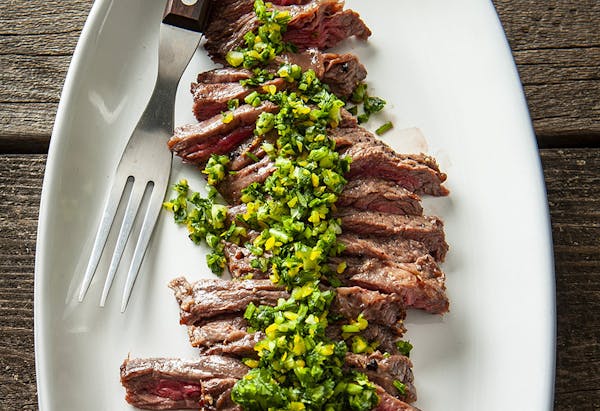Skirt steak is an easy, foolproof cut of beef that's most often used for fajitas, though it can be much more. It's more affordable than a rib-eye or filet.
Skirt steak is thin and long with a visible grain. There are two types — outside and inside — that differ in texture and juiciness quite a bit. The outside skirt is more tender and less coarse, about 4 inches wide and about ½ to 1 inch thick, and noticeably longer than the inside cut.
The inside skirt is wider, about 5 to 7 inches, and about the same thickness as the outside and it is a bit chewier and less juicy. To tenderize this type, use a meat mallet to pound it and make it even thinner. The best way to know which skirt steak you're buying is to ask the butcher.
You can season the steak or marinate it in advance of cooking, but I find that the simplest is the best, allowing the flavor of the meat to shine through completely then serving with a bright, bold condiment.
Use a heavy skillet, preferably cast iron. If the steak is too big to fit, cut it in half. Be sure to dry the surface of the steak, then season it with salt and pepper before cooking. Excess moisture creates steam and keeps the meat from developing that nice firm brown crust.
Sear the steak quickly over very high heat on both sides, slightly undercooking it a little to reduce the danger of going too far. You don't want to cook the steak beyond medium-rare. Let the meat rest for about 5 to 10 minutes so that the fibers relax and it retains the juices. Slice the steak thin (1/4-inch) across the grain, holding the knife at a 45-degree angle to crate a bias cut. The thinner the slices, the less chewy the meat will be.
The rich flavor of this cut takes beautifully to bold flavors — especially Argentine chimichurri and Italian gremolata. These two vibrant parsley-and-garlic-packed condiments are great on accompanying side dishes, too. Try them on roast vegetables, mashed or baked potatoes, and whole grains. You can also swirl them into mayonnaise for sandwiches and dips.
This dinner is a flash in the pan with a bright, herbal kick.
Beth Dooley is the author of "In Winter's Kitchen." Find her at bethdooleyskitchen.com.
Related





